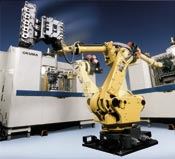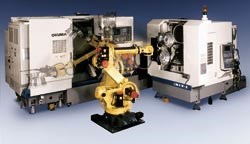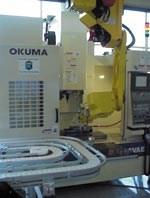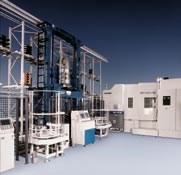CNC Robotics And Automation: Knowing When To Say 'When'
In metalworking, a shop's move from one level of automation to the next can be a business-busting decision if badly timed. This article looks at what you should consider when taking the next step toward automating an operation.
Share


In today’s competitive CNC manufacturing environment, the need for quality is a given, and job shops often win or lose contracts based on per-part costs that vary by just fractions of a cent. Naturally, the promise of achieving cost-efficient, consistent machining results through the use of robotics and automation is attractive to large metalworking concerns and small job shops alike. But many managers considering automation wonder if the time is right for a change. Or, they worry that quality will suffer if they dare to automate the processes they currently rely on for profits.
Like any successful business venture, the move to automation is best approached by following a sequence of orderly steps. Being sure the time is right to make the move to automation can be accomplished in an orderly fashion as well. In fact, there are a number of “machining milestones” any manager can use as a yardstick to gauge a shop’s readiness for robotics. The first of these milestones is the attainment of stability—inherent reliability in the machining process being considered for automation.
Naturally, most shop owners facing automation probably worry at least to some degree about the potential downside. However, many organizations making the switch to automated CNC machine tools find that quality actually increases with the change. Without exception, these shops share one important trait in common: the machining process they are automating has been reliable from the start. John Burg, Automation Division manager for Okuma distributor Ellison Machine Tools and Robotics (Warrenville, Illinois), agrees with this assessment.
"Even ISO 9000 is not strictly about quality,” he says. “It’s more about deciding how you are going to standardize a process, then following through and executing that process according to your standardized plan. That’s also the key to successful CNC machine tool automation. Once you get the process in control and standardize operations, superior quality naturally follows.”
Getting Set Up
Equally important is the need for establishing a controlled process for performing setup. Many owner/operators facing the move to automation are concerned that they’ll incur extra setup requirements to facilitate the use of robotics. In fact, many new users of automated machine tools find that setup time is actually reduced. This is true because once the process is controlled, it is no longer subject to time-consuming variables such as operator preference.
Imagine a part running on the same machine over three shifts daily. Every morning, Operator A sets up his material to the left of his CNC milling machine. At the start of the second shift, Operator B arranges inbound material to right. Later that evening, Operator C stays with B’s material setup but adjusts machining speeds and feeds according to personal preferences.
“I’ve actually walked into shops and found operators working different shifts using their own CNC programs to run exactly the same parts on the same machines,” Mr. Burg recalls. With automation comes the necessity for consistency and controlled setup and working processes. The advent of systematic operations that prescribe material flow, tool selection, chuck type, gripper details, and a host of other parameters also eliminates the type of counter-productive Operator A, B and C scenarios outlined.
The need to tame unbridled fluctuations in rates to keep production—and profits—consistent is another indicator pointing to an impending move to automation. Users of manually loaded CNC machine tools have historically come to expect production rates to vary widely from shift to shift and day to day. In fact, variations in similar processes can vary as much as 30 percent. With automated cells in place, owner/operators typically find that production rates vary less than 5 percent from one shift to another.
As an example, Mr. Burg cited one application that had 14 identical machines operating on a 7-second cycle time to machine aluminum substrate components for computer hard drives. The variations measured from machine operator to machine operator essentially reflected their individual dexterity. While some operators consistently ran more than 2,000 pieces in an 8-hour shift, others could turn out no more than 1,200 good parts.
With automation, the process on all 14 machines immediately produced 4,000 parts per shift. Results were consistent from machine to machine and shift to shift, with variations limited to increments of no more than one-half of one percent. Similarly, tracking spindle uptime as a measure of productivity is another indicator that can clearly point to the need to move to automation.
Staying Power
Most shops find that manually loaded machine tools are functional about 65 percent of the available time. On the other hand, users of automated machine tools can expect their machines to function more than 85 percent of the available time. As real as these numbers are, many shop owners contemplating the move to robotics often find them hard to comprehend.
Mr. Burg points out that managers of shops with four or five CNC machine tools can almost always accurately estimate the number of spindles running at any given time. However, that same task becomes daunting in a shop with 35 or 40 machine tools. In fact, he notes that while his team commonly finds one out of every two spindles down in shops this size, owner/operators doubt the numbers—until they walk the floor, often finding no more than one-third of all their machines making parts on a consistent basis.
“We tell owners, ‘You can put this process in control and automate it. Conservatively speaking, we’re going to give you one free spindle for every four on your shop floor.’ We feel comfortable saying this because with a good robot interface, it’s not at all uncommon for us to easily bring a shop up to 95 percent utilization,” Mr. Burg says.
In fact, today’s extremely reliable machine tools and off-the-shelf components have brought both the cost and availability of automated CNC machining within the reach of shops that only a decade ago might never have considered themselves viable candidates for automation. As recently as the mid-1980s, many early attempts to automate failed due to a combination of high development and installation costs.
Misapplication of robotics, marginally functional equipment, and unsuitable applications for robotics marked other early, but failed, attempts at automation. Simple errors like omitting gaging in automation systems doomed other early systems to fail. A combination of less-than-reliable tools and inconsistent parts with critical dimensions also meant failure.
Cost And ROI
While the ongoing development of machine tool and automation technology has done a remarkable job of keeping pace with industry’s increased demand for more reliable and productive systems, affordability remains as important an issue as ever. Naturally, today’s shop owners typically seek an accurate measure of the return they can expect on their investment in automation. Fortunately, they have at their disposal several sources of financial and technical guidance.
Evaluating the return on investment a shop owner can expect from a move to automation comes down to knowing the market for the parts that will be produced by the cell operation being considered. In fact, it is often the prospect of winning a large contract to machine significant quantities of identical or similar parts that encourages the managers of shops to consider automation in the first place. Of course, the cost of producing those parts is a critical factor in the calculations required to accurately project profitability.
Typically, shop owners can expect the transition to robotics and automation to entail a reasonable payback when a group of two or three machines are involved in the production of similar parts on a regular basis. Ideally, these machines should each have dedicated operators and be running at least two, if not three, shifts daily during the workweek. Even with the variable cost of labor from shop to shop, such a scenario is typically a candidate for a successful automation effort.
Another method of anticipating and evaluating the cost of moving to robotics is to apply a spindle-based calculation. Most owners usually find that when the cost of automating a spindle can be brought within the range of $50,000 per spindle, the time is usually right to make the move to automation. In other words, estimating the cost of a spindle at about $100,000, the projected cost of most successful automation efforts generally falls in the range of 50 percent of the cost of the CNC machine tool.
Of course, part weight, operator fatigue and other factors that put operators at risk of on-the-job injuries can skew calculations to the point that can justify even greater investments in robotics and automation. Fortunately, machine shop managers are not faced with making these decisions alone.
It is currently a trend for machine tool distributors to have both metalworking and automation expertise under one roof. A distributor like Ellison offers exactly this mix of services to its customers. “Typically, shop owners rely on their relationship with a distributor to gain the required access to any one of a number of automation suppliers or a third-party integrator who will then join the team to begin exploring solutions for a shop’s program.
“Some years ago, Okuma decided to climb the learning curve with the dedication of its Okuma Technology Institute,” Mr. Burg says. The Charlotte, North Carolina-based facility is home to Center for Advanced Manufacturing Technology. From the start, OTI worked with builders of systems ranging from conveyors and loaders to quality control and trend monitoring. “Today, those programs are the basis of the services that alter distributors without in house staff and resources can offer their customers.”
The interchange between members of the builder’s distributor network resembles a simplified version of the technology transfer efforts commonly seen on a global basis in contemporary high-technology industries. In practice, Mr. Burg and his team may work with an associate Okuma distributor in a remote location at the request of factory officials.
Working through OTI, Ellison Automation helps the associate Okuma distributor put in place the robotics and automation technology his customer requires. Conversely, if that customer has expertise in shaft turning for hydraulic components that Ellison lacks, that working knowledge can benefit customers in Illinois as the transfer of acquired process knowledge finds its way back through the OTI network to an Ellison customer.
The Vision Thing
Looking ahead, Mr. Burg and others predict that robotic vision technology promises to be the next emerging frontier in automaton. Instead of having a fixture that holds a part to be machined in a specific orientation so the robot knows where to pick it up, today’s automation cells include vision cameras to guide robots. Now operators can simply set a part on a conveyor with an accuracy of plus or minus an inch, and the robotic arm will seek, acquire and grip the part for loading.
Make no mistake; robotic vision technology existed in the mid-1980s. However, only recently have costs fallen to the point that including a camera and the associated software in a system is cost-effective. Vision capabilities that formerly cost in excess of $100,000 for hardware alone can now be brought online for a total cost of about $12,000. Furthermore, software advances have simplified system operations to the point that no special knowledge of programming or engineering is essential to successful operations.
As the metalworking industry becomes increasingly more competitive, more owner/operators are looking to robotics and automation for solutions to the pressures they face to remain productive and profitable. With the proliferation of manufacturers specializing in motion control, workhandling, tooling and software applications for CNC machine tool automation, there has probably never been a more advantageous time for medium- to small-size shops to evaluate a move to automation.
“Today there are viable and economical automation solutions in applications that just ten years ago may have been quite a stretch,” says Mr. Burg. “There is a wealth of expertise available in the marketplace to help shop managers make the transition to robotics. Affordable, off-the-shelf components that facilitate the process are widely available, and many shops have already begun the process of moving to automated CNC cell manufacturing. And, oh by the way—if you have not yet started to evaluate automation—keep in mind that your competitors probably already have.”
About the author: Dan Barbera is Director of Marketing for Okuma American Corporation.
Related Content
Increasing Productivity with Digitalization and AI
Job shops are implementing automation and digitalization into workflows to eliminate set up time and increase repeatability in production.
Read MoreCutting Part Programming Times Through AI
CAM Assist cuts repetition from part programming — early users say it cuts tribal knowledge and could be a useful tool for training new programmers.
Read More4 Manufacturing Trends That Cannot Be Ignored
The next five years will present their own unique set of challenges, and shops can alleviate them by embracing these technologies and trends.
Read MoreAddressing Manufacturing Challenges with Automation
GrayMatter Robotics’ Physical AI robotic cells for manufacturing offer immediate impact and results.
Read MoreRead Next
OEM Tour Video: Lean Manufacturing for Measurement and Metrology
How can a facility that requires manual work for some long-standing parts be made more efficient? Join us as we look inside The L. S. Starrett Company’s headquarters in Athol, Massachusetts, and see how this long-established OEM is updating its processes.
Read More






























